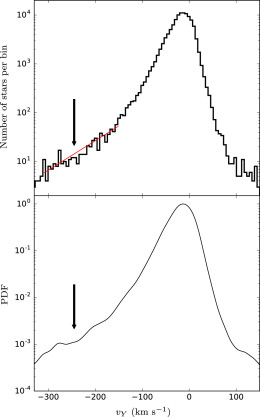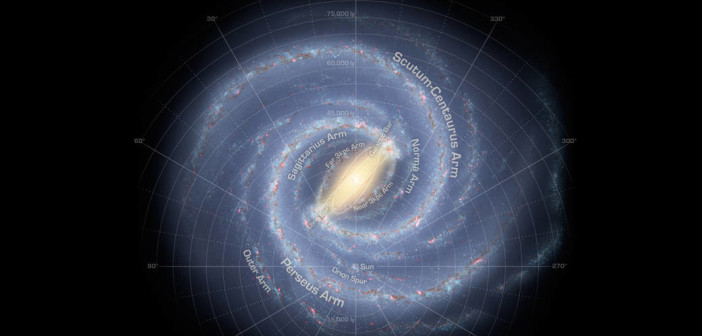Though we don’t notice it from our point of view, we’re hurtling through space at breakneck speed — and one of the contributors to our overall motion through the universe is the Sun’s revolution around the center of our galaxy. A recent study uses an unusual approach to measure the speed of this rotation.
Moving While Sitting Still
We know that the Sun zips rapidly around the center of the Milky Way — our orbital speed is somewhere around 250 km/s, or ~560,000 mph! Getting a precise measurement of this velocity is useful because we can combine it with the observed proper motion of Sgr A*, the black hole at the center of our galaxy, to determine the distance from us to the center of the Milky Way. This is an important baseline for lots of other measurements.

Example particle orbits modeled within the galactic potential. The top panel represents a star with zero angular momentum, which is scattered into a chaotic orbit after interacting with the galactic nucleus. [Hunt et al. 2016]
Missing Stars
The stars around us should exhibit a distribution of velocities describing their orbits about the galactic center — but those stars with zero angular momentum should have plunged directly into the galactic center long ago. These stars would have been scattered onto chaotic halo orbits after their plunge, resulting in a dearth of stars with zero angular momentum around us today.
By looking at the relative speeds of the stars moving around us, then, we should see a dip in the velocity distribution corresponding to the missing zero-angular-momentum stars. By noting the relative velocity at which that dip occurs, we cleverly reveal the negative of our motion around the galactic center.

Velocity distribution for stars within 700 pc of the Sun. A dip in the distribution (marked with an arrow) is noticeable between –210 and –270 km/s. [Hunt et al. 2016]
Where Are We and How Fast Are We Going?
Hunt and collaborators use a combination of the first data release from ESA’s Gaia mission and a star catalog from the Radial Velocity Experiment to examine the motions of a total of over 200,000 stars in the solar neighborhood. They find that there is indeed a lack of disk stars with velocities close to zero angular momentum. They then compare modeled stellar orbits to the data to estimate the relative speed at which the dip in the velocity distribution occurs.
From this information, the authors obtain a measurement of 239±9 km/s for the Sun’s revolution velocity around the galactic center. They combine this value with a proper motion measurement of Sgr A* to calculate the distance to the galactic center: 7.9±0.3 kpc (or about 26,000 light-years).
Both of these measurements can be improved with future Gaia data releases, which will contain many orders of magnitude more stars. This clever technique, therefore, proves a useful way of better constraining our position and motion through the Milky Way.
Citation
Jason A. S. Hunt et al 2016 ApJL 832 L25. doi:10.3847/2041-8205/832/2/L25

1 Comment
Pingback: our motion in the MW